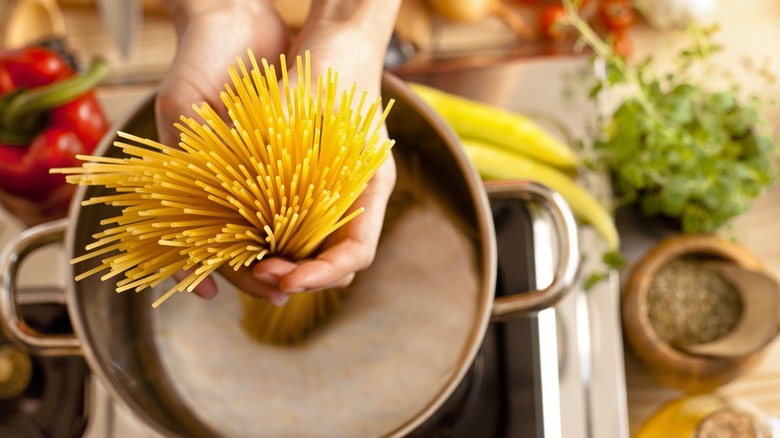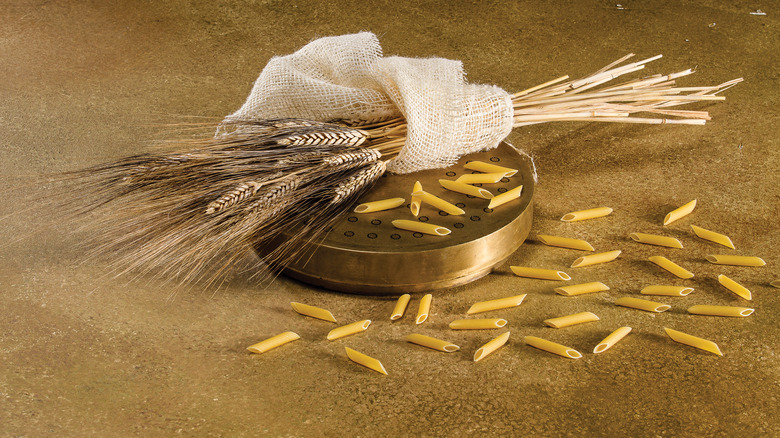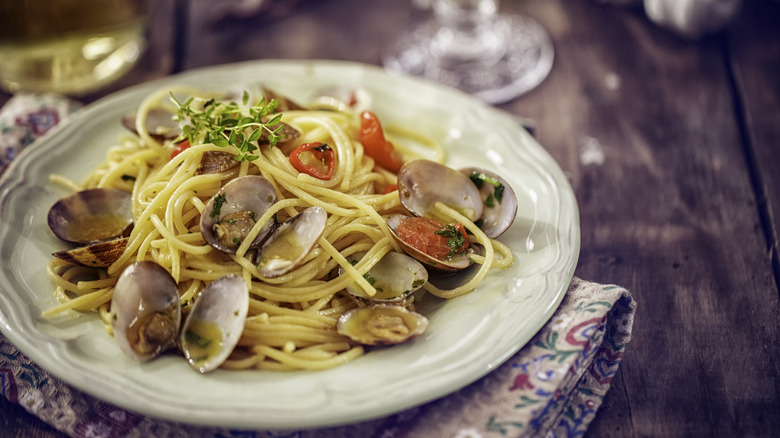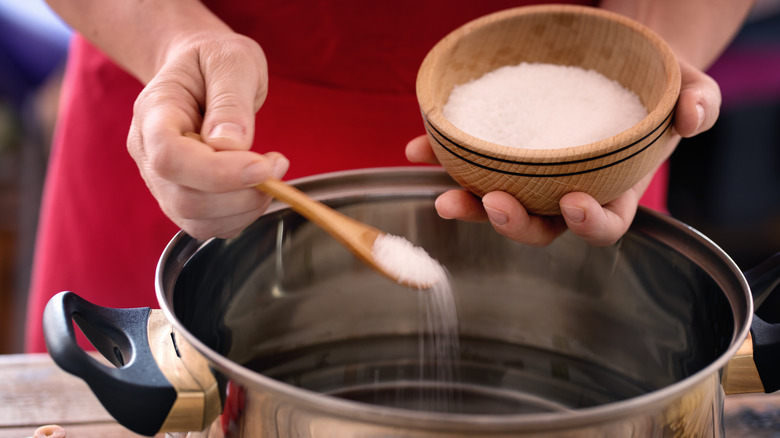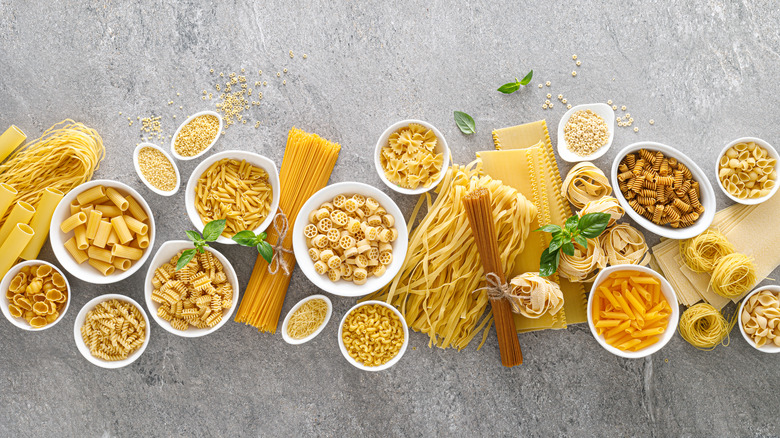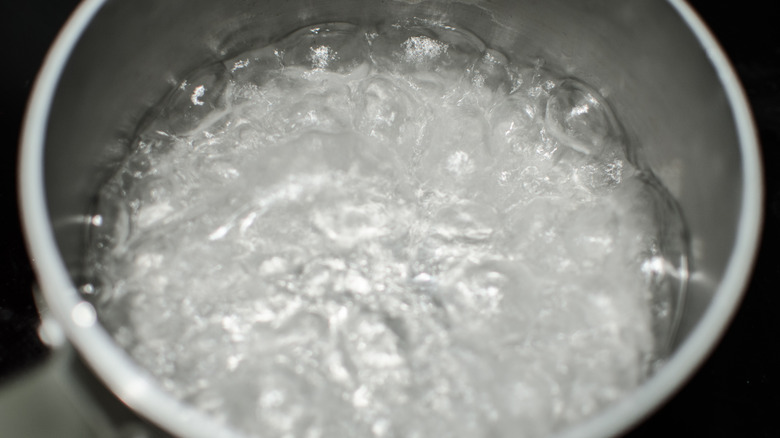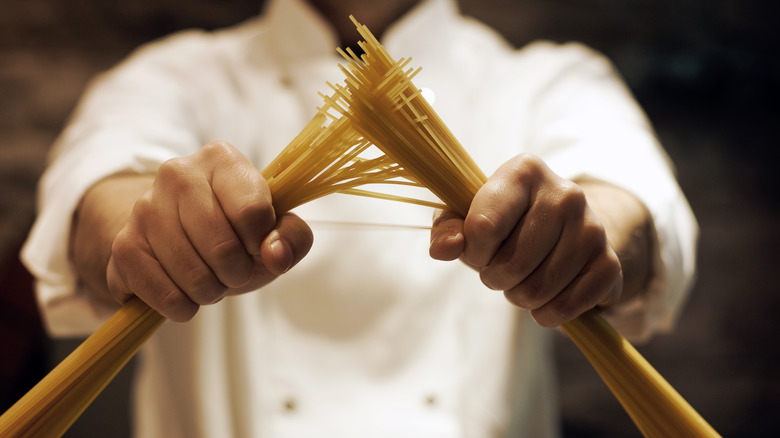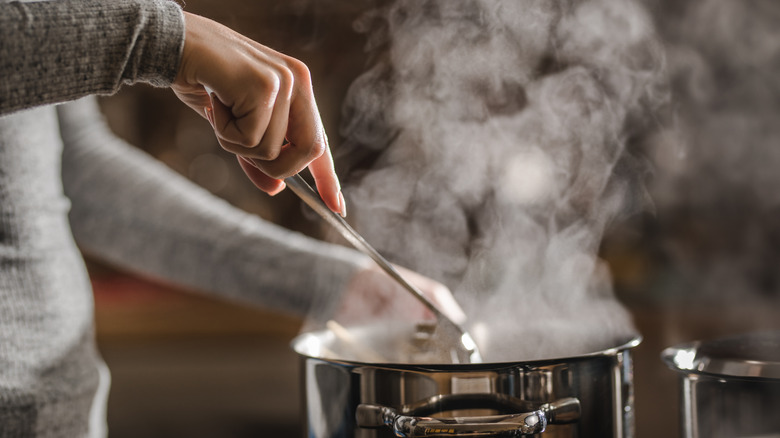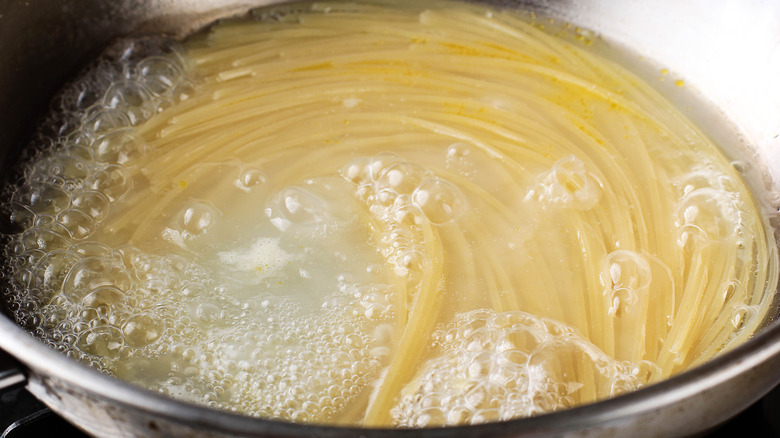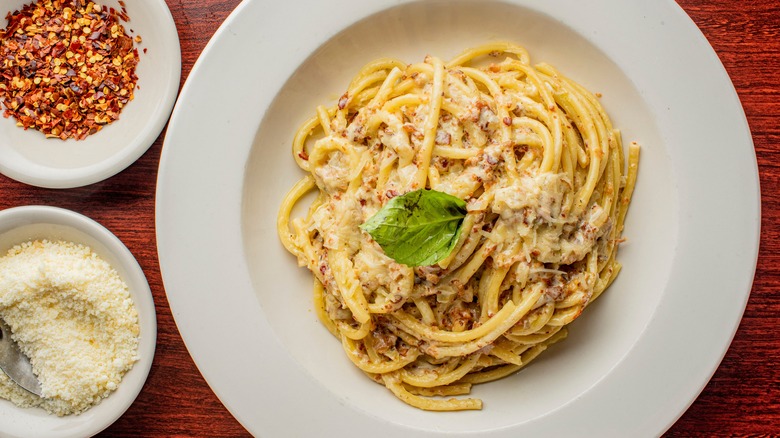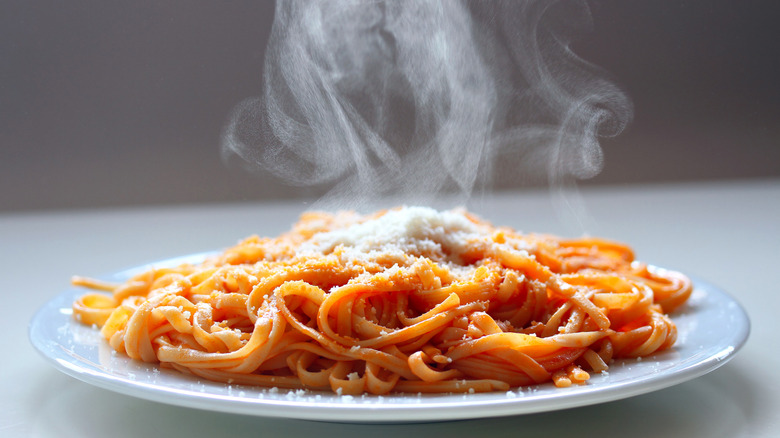11 Tips You Need When Cooking Spaghetti
We may receive a commission on purchases made from links.
Whether doused in classic Bolognese, swirled in creamy carbonara, or simply topped with some butter and Parmesan cheese, few could deny that spaghetti is the ultimate comfort food. In fact, when it comes to pasta, Americans consume about 20 pounds of the stuff per capita per year, and prefer long noodle shapes like spaghetti.
While noodles made from wheat and eggs have a long history in both Asia and the Mediterranean, the spaghetti we know and love today likely originated in Sicily in the 8th century. Since these humble beginnings, the noodles have earned a reputation throughout the world as a delicious and versatile base for some of our favorite pasta dishes.
Spaghetti, like most pasta shapes, is traditionally made from durum wheat — a hard wheat that yields highly glutinous flour and very little else — in some cases just water; in others, eggs and perhaps a touch of oil. On its own, it doesn't taste like much, which is why proper cooking techniques are essential to turning this bland food into something magical. However, even the most delicious sauce can't hide sticky, overcooked, poorly made noodles, so here are several tips to ensure your noodles pass even the strictest Italian nonna's taste test.
1. Start with bronze cut pasta
Any great chef will tell you that you need to start with quality ingredients to create a great dish, and spaghetti is no different. Have you ever taken a closer look at your dried noodles and noticed that some have a smooth, shiny texture, while others look a bit rough? This is the result of how each noodle is cut in the factory and is an important factor to consider when shopping for your pasta.
Noodles with a rougher surface have been cut using a bronze die, which foodies will tell you is the gold standard and a non-negotiable when it comes to quality pasta. The bronze die creates a rough texture that ensures your sauce adheres beautifully to each individual noodle. In contrast, noodles that have a smooth, shiny finish have been cut using a Teflon die, which was introduced as a cheaper, quicker, more industrialized option for pasta brands. As you might imagine, the smoother surface means the sauce doesn't adhere quite as well, slipping off your noodles and often pooling in your bowl instead. While the bronze-cut spaghetti may cost a bit more, the splurge is worth it to ensure each bite has the perfect sauce-to-noodle ratio.
2. Make sure you pick the right type of sauce
You've got a great bowl of noodles and a delicious sauce –- that's all that matters, right? Not if you're trying to step up your culinary game. Certain sauces are meant for long noodles like spaghetti, whereas others are meant for short pasta shapes. "Even if you have done everything else right when producing a dish of pasta ... your dish might not be completely successful unless you have given thought to matching pasta type and shape to a congenial sauce," warns Marcella Hazan in her book Essentials of Classic Italian Cooking.
Long pasta shapes, like spaghetti, tend to do well with sauces that are relatively smooth –- although some texture is okay. Think cacio e pepe, carbonara, simple marinara, or rustic aglio olio (garlic and olive oil). Of course, spaghetti alle vongole (with clams) is always a favorite. And, when it comes to stepping up spaghetti noodles, don't be afraid to experiment with non-Italian flavors like peanut, sesame, and Sichuan pepper.
3. Salt that water, bae
You know the recipe step: "Salt your pasta water." However, an amount is rarely offered, and most assume a pinch of salt is enough. Adequately salting your pasta water may actually be the most crucial step in creating a delicious spaghetti dish. Here is where you need to throw caution to the wind and just toss a generous handful in there.
This may feel scary, but any Italian cook will tell you the water should taste like the sea before adding your noodles. In fact, you will know you have properly salted your pasta water if it is delicious enough to eat on its own with nothing more than a quick drizzle of olive oil, so be brave!
If you're feeling particularly adventurous, you may even try boiling your spaghetti noodles in something other than water. For example, chicken or vegetable broth –- already packed with salty, savory flavors –- may add an unexpected depth to your pasta.
4. Fresh isn't necessarily best
It's unclear when or why this happened, but there is a misconception that fresh pasta is better than dried pasta. Some believe it's because fresh pasta is, well, fresher. Others attribute it to the fact that it can be the calling card of some high-end Italian restaurants. According to chef Michael Friedman of The Red Hen in Washington, D.C. as quoted in the Washington Post, if you had mastered the art of fresh pasta as a chef, it meant "you were at the height of your craft."
The truth is, while there are several differences between the two types of pasta, the primary difference between fresh and dried is that the former is made with eggs. And, much like certain pasta shapes are better suited to certain types of sauces, the same goes for fresh versus dried. Dried pasta can typically stand up to heartier sauces, given its sturdier texture. Fresh pastas prefer smooth, silky, cream- and butter-based sauces. These coat the noodles beautifully and often elevate the flavors that come from the addition of eggs to the pasta dough.
When it comes to spaghetti, dried pasta is usually the standard. But, if you can get your hands on some (or are brave enough to make it on your own), spaghetti a la chitarra — a toothy fresh pasta that is made using a wire-strung wooden frame reminiscent of a guitar, or "chitarra" — is a real treat with tomato-based sauces.
5. Bring your water to a boil before dropping the pasta
There is a lot of debate and experimentation out there surrounding how much water to use and what the ideal temperature is for the best pasta. Many of these experiments seek to reduce the costs associated with boiling a pot of pasta in terms of time, energy, and money. While you can certainly conduct scientific trials on your own, we prefer not to overcomplicate things and focus instead on getting delicious spaghetti on the table as quickly and effectively as possible.
To that end, we suggest making sure the water is fully boiling before salting it. Then, allow it to return to a boil and add your spaghetti noodles. Not only will this ensure that the noodles cook evenly, but it will also reduce the amount of attention needed on your part. And, the flavor may benefit as well. Lidia Bastianich, one of the foremost authorities on Italian cooking, in experimenting with different temperatures for cooking pasta for a piece in The New York Times, found that the pasta cooked in cold water was lacking in flavor and agreed that adding noodles to boiling water is indeed best.
6. Oil and water don't mix
There's a reason the expression "like oil and water" is used to describe two things that don't mix well together. Unlike certain substances that attract one another, oils are hydrophobic — literally, water-fearing. Rather than becoming a homogenous mixture when blending the two substances, oil molecules are actually repelled by water molecules.
What does this have to do with making a great pot of spaghetti? Resist the urge to add oil to your water when cooking your noodles! You may think this will help keep them from sticking together, but it will instead just make your noodles slippery, preventing your pasta sauce from adhering to them. Think of your sauce like water to the oil; where you want the sauce to stick to your noodles, coating them in oil will simply repel that sauce like water. Plus, your sauce will likely have some element of fat in it, either from the addition of oil, butter, or meat rendering its fat while cooking (or all three!), so this will help lubricate things when your noodles hit the pan.
7. Bend, don't break your spaghetti
Maybe you don't love the idea of twirling your spaghetti for days to get it to sit nicely on your fork. Maybe you only have a tiny pot at your disposal. Either way, try to avoid breaking your spaghetti noodles in half before adding them to the water. They were made to be long for a reason. And, you don't want to horrify all the Italian chefs out there with this unnecessary step.
Not only will your long spaghetti noodles gradually soften as they hit the boiling water, allowing them to bend and fit the shape of your pot, but spaghetti noodles are the length they are precisely so you can swirl them. The signature spaghetti swirl is what allows these noodles to soak up that sauce and wrap sufficiently around your fork. Any shorter, and they will slip right off. You don't want to have to work harder than necessary to get your spaghetti into your mouth, right?
8. Don't forget to give it a stir
Spaghetti noodles get really sticky because of their starch content. To avoid unnecessary clumping, be like Bob Marley and stir it up once those noodles hit the boiling water. This is especially important early on in the cooking process as that first blast of water will immediately loosen the starch of the noodles and cause them to stick together. You will want to break up the party early to make sure your noodles separate and cook evenly.
Don't feel the need to overdo it, though. Pasta is not like risotto in that you don't have to stir it constantly to ensure the best results. Unless you've crammed too much into a small pot with a minimal amount of liquid — in which case you will definitely want to stir fairly frequently — a quick stir every few minutes should ensure your noodles stay separated from one another and that no messy clumps form. It will also make sure the heat from the water accesses the whole surface of each noodle so that there are no uncooked areas during the boiling process.
9. Al dente should always be the goal
If you take one thing from this guide, let it be this: do not ruin spaghetti by overcooking it. Perhaps the cardinal rule of making great pasta, any Italian chef will stress the importance of texture when it comes to your noodles. The goal is al dente, not rubbery mush.
Translating to "to the tooth," al dente pasta has that distinct, slightly chewy texture that makes it so satisfying to eat. According to popular pasta brand Barilla, cooking your noodles too long can actually cause a spike in your blood sugar, making the al dente version more nutritional as well.
The trick is to time your noodles carefully when cooking them. Most commercial pasta brands will have a suggested cooking time on the package. To be on the safe side, opt for the lowest end of the range if one is offered, or even a minute or so less than the suggested time. Your noodles will continue to cook from carry-over heat when you drain them and when you add them to your sauce. Even if they are still a bit firm when you drain them, they will end up perfectly al dente when you're ready to serve them.
10. Everything's better with butter
From freshly baked bread to popcorn to baked potatoes, corn on the cob, lobster, and more, we can all agree that butter is welcome at just about any party. There's something about that creamy, fatty tang that butter offers that makes everything taste better. Noodles are no exception.
While we all love the ultimate comfort food of a steaming bowl of spaghetti dressed in butter — a meal that instantly takes us all back to our picky eater days going out to dinner and requesting butter noodles — this simple ingredient is also an amazing addition to most sauces. Whether you're preparing a sauce for spaghetti or another dish, consider doing what the culinary world has long referred to as mounting, or "monter au beurre," the technique of stirring in cold butter at the end of the cooking process,
In the final stages of cooking, turn off the heat and plop in a few pats of butter to your pasta sauce. Whisk them until they are melted and evenly incorporated, and watch your sauce go from good to silky and restaurant-worthy.
11. Preheat your serving dish
Like overcooked pasta, cold spaghetti leaves little to be desired. Where some dishes like risotto and hearty braises seem to hold heat indefinitely, often resulting in that unmistakable scorched mouth experience when hunger trumps patience, noodles cool relatively quickly. Extend their piping hot life by preheating your pasta dish before serving up. You can do this by filling each bowl or your serving dish with hot or boiling water and letting them sit for a few minutes as you finish cooking your spaghetti. Or, some microwaves and ovens have a dinner plate setting that allows you to safely preheat dishes so that your food stays warm longer when serving.
This will ensure that when you dole out your perfectly al dente spaghetti — tossed in your pan of expertly selected sauce finished with a dollop of butter and a ladle of pasta water — you have a hot, well-prepared dish of spaghetti that would make Marcella Hazan and Lidia Bastianich proud.
